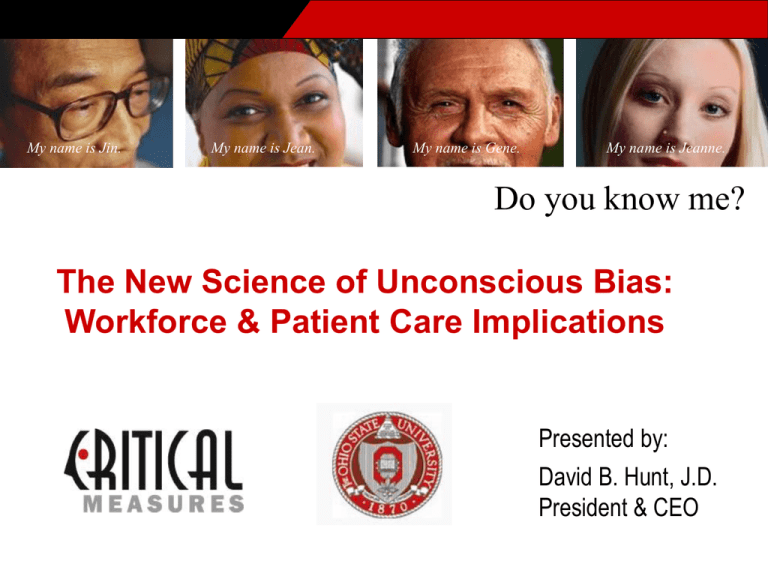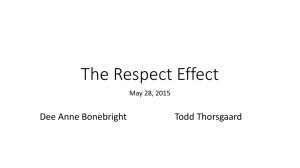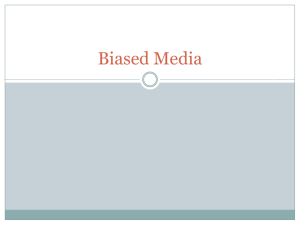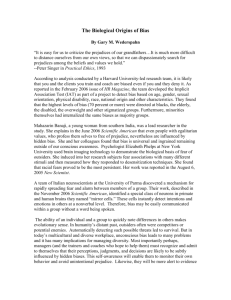OSU Webinar Unconscious Bias 2015
advertisement

My name is Jin. My name is Jean. My name is Gene. My name is Jeanne. Do you know me? The New Science of Unconscious Bias: Workforce & Patient Care Implications Presented by: David B. Hunt, J.D. President & CEO About Us: Critical Measures - Evidence-based healthcare consulting and performance improvement services. Focus: health equity and cross-cultural healthcare. - Partnered with Harvard MD’s to create nation’s first e-learning program on cultural competence for physicians and nurses. - Created nation’s first e-learning program on The Law of Language Access in Healthcare (2010) - Conducted national webinars on the law of language access in health care for the ABA and the AHA (2012). - Selected by BCBSA in 2013 as one of two national vendors for cultural competence training and consulting services - National and international presentations on The New Science of Unconscious Bias. - Released nation’s first e-learning program on Global Medicine (2014) Agenda • • • • • • Three Demographic Megatrends Implications for Hospitals and Healthcare The New “Science of Unconscious Bias” Workforce & Employment Law Implications Patient Care Implications (Provider & Patient Biases) Becoming Conscious of Unconscious Biases – Next Steps For Individuals and Organizations Three Demographic Megatrends Changing Demographics – Race • Between now and the year 2050, almost 90% of U.S. population growth will come from Asian Americans, African-Americans and Hispanic-Americans. • Today, people of color are already a majority in 48 of the nation’s 100 largest cities. • Today, four states have “minority majorities.” They include: California, Hawaii, New Mexico and Texas. • Six other states: Maryland, Mississippi, Georgia, New York, Florida and Arizona have non-white populations around 40%. Source: “The Emerging Minority Marketplace: Minority Population Growth 1995-2050.” U.S. Census Bureau September 21, 1999. Trends in U.S. Immigration • 1 of 10 global citizens today is a migrant. • Immigration to the U.S. has tripled in the last 30 years. • During the 1990s, the U.S. received over 13 million immigrants – the largest number in our nation’s history. • We broke even that mark during the last decade. • There are 40 million foreign born in the U.S. today (13%) • Significantly, most immigrants today no longer come from Western European nations with whom we have the most in common historically…. Immigrants Bring New Cultural Influences • Religion: Islam is now the fastest growing religion in the U.S. • Language: Over 20 percent of Americans 5 years old and older speak a language other than English at home, with nearly half of those claiming to speak English less than "very well." • America is now more linguistically diverse than Western Europe. • 43% of California’s population now speaks a language other than English at home. Four other states over 30%. Implications for Hospitals What is Cross-Cultural Healthcare? 1. Disparities in Patient Outcomes – Race, Gender, GLBT 2. Providing Language Access to LEP Patients/Families A. Medical - Quality/Safety Issue B. Legal - Civil Rights Issue (Title VI, ADA) 3. Medical Disparities Resulting from Globally Mobile Populations Institute of Medicine Finds Racial and Ethnic Disparities in Quality of Care • People of Color receive lower-quality health care than whites do, even when insurance status, income, age and severity of conditions are comparable. • People of Color more likely to be treated with disrespect by the health care system and more likely to believe that they would receive better care if they were of a different race. • Major disparities found in many key diagnostic areas: cardiovascular disease, cancer, stroke, kidney dialysis, HIV/AIDS, asthma, diabetes, mental health, maternal and child health. • The overall death rate for blacks today is comparable to the white death rate of thirty years ago. 100,000 blacks die each year who would not die if the death rates were equivalent. Racial Disparities Have Worsened Since Issuance of the IOM Report • It has now been many years since the Institute of Medicine issued its clarion call for improving the quality of healthcare for the nation’s minorities. • While some strides have been made, quality gaps continue. A recent Agency for Healthcare Research and Quality (AHRQ) report notes that over 60 percent of disparities in quality of care have stayed the same or worsened for blacks, Asians and poor populations while nearly 60 percent of disparities, including but not limited to quality issues have stayed the same or worsened for Hispanics. Racial Disparities Costs Nation $57 Billion Per Year • Racial health disparities in infant mortality, chronic disease and many other metrics cost the U.S. health system more than $57 billion a year, according to a report authored by researchers from Johns Hopkins University and the University of Maryland. (Joint Center for Political and Economic Studies (a Washington, D.C. think-tank) September, 2009) Few Hospitals Collect Race/Ethnicity Data and Tie it to Patient Outcomes. • NPHHI asked hospitals that collect race and ethnicity data whether they used it to assess and compare quality of care, utilization of health services, health outcomes or patient satisfaction across their different patient populations. • Sadly, less than 20 percent of surveyed hospitals collect patient race and ethnicity information and tie it to patient outcomes and quality improvement. Medical Case for Language Access in Healthcare – Improved Quality, Safety 1. Language barriers are associated with poor quality of care in emergency departments; inadequate communication of diagnosis, treatment and prescribed medication; and higher rates of medical errors. 2. According to one study, no interpreter was used in 46% of emergency department cases involving patients with LEP. 3. Few clinicians receive training in working with interpreters; only 23 percent of U.S. teaching hospitals provide any such training and most make it optional. 14 Medical Case for Language Access in Healthcare – Improved Quality, Safety 4. Glenn Flores conducted research on mistakes by inadequately trained interpreters. His results showed: • An average of 31 mistakes per doctor-patient visit • Two-thirds could have negative consequences for patients 5. According to the Joint Commission, fully half of LEP patients who reported adverse events experienced some degree of physical harm – compared to less than a third of English speaking patients. 6. The same report found that the rate at which LEP patients suffered permanent or severe harm or death was more than twice that of English-speaking patients. 15 We may assume they understand… • Patients leaving the physician’s office with a good understanding of what they are told 90% 80% 80% 70% 60% Reported by Physicians 50% 37% 40% Reported by Patients 30% 20% 10% 0% 1 Intermountain Healthcare study, 2005 – IOM More Hospitals Seeing LEP Patients 1. More hospitals are seeing LEP patients. A. 80% of American hospitals encounter LEP frequently. B. 43% of hospitals encounter LEP patients daily, 20% of hospitals encounter LEP patients weekly,17% of hospitals encounter LEP patients monthly. 2. Yet less than 30 percent of U.S. hospitals have quality improvement efforts underway to improve the quality of their language access programs. 17 With 1 billion people crossing international borders each year, there is no where in the world from which we are remote and no one from whom we are disconnected. US Estimated Annual International Arrivals Refugees 70 – 90,000 Immigrants >1,000,000 International Travelers Foreign 60M / U.S. 60M *Presidential request for refugee admissions: 70,000 refugees Source: U.S. Department of Homeland Security Sometimes It Looks Like A…. • Horse … • And gallops like a horse … • But it’s a ….. Moral: In A Globally Mobile World, Today’s Doctors Are Seeing More… Understanding the New Science of Bias Awareness: New Research re: Bias 1. In the past, bias was regarded as aberrant, conscious and intentional. 2. Today, we understand that bias is normative, unconscious and largely unintentional. 3. Social Cognition Theory establishes that mental categories and personal experiences become “hardwired” into cognitive functioning. 4. As a result, human biases can be seen as evolutionarily adaptive behaviors. Unconscious Bias: How Does It Work? • The problem? Too much information to process. Scientists estimate that we are exposed to as many as 11 million pieces of information at any one time, but our brains can only functionally deal with about 40. • The solution? Mental short-cuts. – The brain seeks to conserve energy. – Decision-making, ambiguity, novelty and problem solving all take heavy cognitive reserve. – We’ve evolved to have mental short cuts that save time and usually yield reliable results. • The brain as a predictionmachine • Wired for threat identification • Seeks the simplest path to conclusions Perceptions of “Groupness” Distort Perception and Behavior 1. 2. 3. 4. 5. 6. Experiments by Tajfel and others showed that, as soon as people are divided into groups – even on trivial or random bases – strong biases resulted. Subjects perceived members of their group as more similar to them and members of other groups as more different. Subjects saw in-group members highly differentiated individuals and out-group members as largely homogenous. Subjects were better able to recall undesirable behavior of outgroup members than similar behavior of ingroup members. Ingroup members failures were attributed to situational factors while outgroup failures were attributed to innate characteristics. Subjects permitted to allocate monetary rewards maximized rewards to their own group and minimized rewards to outgroups. The Implicit Association Test What Activates Our Biases? Our biases are most likely to be activated by four key conditions. They are: stress time constraints multi-tasking need for closure https://implicit.harvard.edu Key IAT Findings - Age • Age: Around ninety percent of Americans mentally associate negative concepts with the social group "elderly"; only about ten percent show the opposite effect associating elderly with positive concepts. Older people do not, show an automatic preference for their own group. Remarkably, the preference for “young” is just as strong in those in the over-60 age group as it is among 20year-olds. Key IAT Findings - Gender • Gender: Seventy-five percent of men and women do not associate female with career as easily as they associate female with family. (Women show an implicit attitudinal preference for females over males, but they nonetheless show an implicit stereotype linking females closer to family than career.) Key IAT Findings - Race • Race: White participants consistently show a preference for White over Black on the IAT – a substantial majority of White IAT respondents (75% to 80%) show an automatic preference for White over Black. Data collected from this website consistently reveal approximately even numbers of Black respondents showing a pro-White bias as show a pro-Black bias. • Other key race findings: younger people are just as likely to display an implicit race bias as older adults, women are as likely to display an implicit race bias as men and educational attainment appears to make no difference with respect to implicit race bias. Workplace Implications Biases Impact Decisionmaking Unconscious bias can infect management decisions throughout the employment life cycle: a. Interviewing. Recruitment, hiring & retention. b. Expectations of and interactions with employees. (“Micro-inequities”) c. Employee evaluations. (“Set Up to Fail Syndrome” – Harvard Business Review) d. Decisions about promotions, training and other job benefits. e. Termination and discharge decisions. The “Big Five” Orchestras • Chicago and Boston – None of the Big Five employed more than 12% women until the 1980’s – Blind auditions • Improved the chances that a woman would ultimately be hired • Female musicians in the Big Five increased five-fold from 1970 to 2000 Orchestrating Impartiality: the Impact of “Blind” Auditions on Female Musicians, 94 Am. Econ. Rev. 715 (2000). Susan Boyle – Britain’s Got Talent – Great talent often doesn’t look and act like you… – Can you spot great talent no matter how it is “packaged”? Are Emily & Greg More Employable than Lakisha & Jamal? • Study of actual racial hiring bias in Chicago and Boston – Resumes sent to actual want ads • 4 resumes per position – 2 “high” quality and 2 “low” quality • African American sounding names assigned to one high quality and one low quality – Primary measurement was the “callback” rate – Results: people with "white-sounding" names are 50 percent more likely to get a response to their resume than are those with "blacksounding" names. Marianne Bertrand and Sendhil Mullainathan, Are Emily and Greg More Employable Than Lakisha and Jamal? Field Experiment on Labor Market Discrimination, 94 Am. Econ. Rev. 991 (2004). Diversity and Productivity • Effective diversity programs are associated with higher productivity (+18%). (National Urban League, 2004) • Gallup found that 27.7 million U.S. workers, or 18%, are actively disengaged. Another 52% of workers were not engaged, while only 30% of workers were actively engaged. Result: 70% of workers are not fully engaged. • “Actively disengaged" employees -- those fundamentally disconnected from their jobs -- cost the U.S. economy between $450 billion and $550 billion a year. (Gallup 2012) • What causes workers to disengage at work? One notable cause is DRI’s – Diversity Related Incident’s of Disrespect. Workplace Incivility – DRI’s • Studies have found that over 71 percent of the workforce has experienced some form of workplace incivility in the last five years. Incivility is evidenced by disrespectful behavior. Source: Don Zander, Brookings Institution, 2002 • Of the reported incidents of workplace-related DRI’s: 32% were related to gender; 28% were related to race; 20% were related to age; 14% were related to sexual orientation and 6% were related to religion. Workplace Incivility – DRI’s Fiscal Impact of Workplace Incivility: Of those who experienced work-place related DRI’s: • • • • • • 28% lost work time avoiding the instigator of the incivility; 53% lost time worrying about the incident/future interactions; 37% believe their commitment at work declined; 22% have decreased their effort at work; 10% decreased the amount of time that they spent at work; 12% actually changed jobs to avoid the instigator. Source: The Sparticus Group: 2003. Racial Discrimination Among NBA Referees Price, Joseph and Wolfers, Justin, "Racial Discrimination Among NBA Referees," NBER Working Paper Series, Vol. w13206 (2007). Available at http://www.nber.org/papers/w13206.pdf Does Unconscious Racial Bias Affect Trial Judges? This article reports the results of the first study of implicit racial bias among judges Jeffrey J. Rachlinski, Sheri Lynn Johnson, Andrew J. Wistrich & Chris Guthrie, Does Unconscious Racial Bias Affect Trial Judges?, 84 Notre Dame L. Rev. 1195 (2009) Race, Ethnicity and Perceptions of Workplace Relationships in Healthcare Management White Race relations within my company Women 79% are good. Men 90% Managers of Color usually have to Women 6% be more qualified to get ahead here. Men 3% White managers share vital growth Women 57% and career-related information with Men 55% managers of color. The evaluation of both whites and Women 69% employees of color are equally Men 75% thorough and carefully evaluated . Has a strong feeling of belonging Women 82% to the organization. Men 85% Asian 60% 70% 29% 33% 29% 37% Black 41% 53% 75% 66% 10% 12% Hispanic 55% 73% 47% 35% 18% 30% 51% 50% 18% 22% 33% 43% 70% 72% 58% 72% 71% 79% Source: A Race/Ethnic Comparison of Career Attainment in Healthcare Management: American College of Healthcare Executives; Institute for Diversity in Healthcare Management, 2002 EEOC Charge Data FY 2002 – FY 2012 Total Charges Race Sex National Origin Religion Age Disability Retaliation FY 2002 84,442 29,910 25,536 9,046 2,572 19,921 15,964 22,768 FY 2012 99,412 33,512 30,356 10,883 3,811 22,857 26,379 37,836 % +15% +11% +16% +17% +32% +13% +39% +40% Source: Equal Employment Opportunity Commission website: http://www.eeoc Where Are We Today? • 1 out of every 3 civil cases today is an employment law case. • A single legal claim arising out of employment issues can cost an employer $750,000. That "price tag" includes the average recovery of a successful plaintiff, attorneys' fees paid to the plaintiff's attorney, and the cost of hiring an attorney to defend the claim. • The average jury award for wrongful termination claims is $1.8 million and one-fifth of jury awards now top the $1 million mark. • Eighty-two percent of HR professionals surveyed found employment law training to be effective or extremely effective in reducing litigation. • With the average cost to settle a lawsuit hovering at $300,000, a training program that eliminates even one lawsuit presents an amazing return on investment. Patient Care Considerations The Effect of Race and Sex on Physicians' Recommendations for Cardiac Catheterization • 720 physicians viewed recorded interviews • Reviewed data about hypothetical patient • The physicians then made recommendations about patient's care a that Source: Schulman et.al. NEJM 1999;340:618. New Study Finds Unconscious Bias In M.D. Decision-making • • • • Emergency room doctors in the study were told two men, one white and one African-American, were each 50 years old and complained of chest pain. The patients were not actually real people, but rather computer-generated images seen by the doctors only on a monitor. After the doctors in the study evaluated the two simulated patients, they were then given an implicit association test examining unconscious racial biases. The result was most of the doctors were more likely to prescribe a potentially life-saving, clot-busting treatment for the white patients than for the AfricanAmerican patient. The study, by the Disparities Solutions Center, affiliated with Harvard University and Masschusetts General Hospital, is the first to deal with unconscious racial bias and how it can lead to inferior care for AfricanAmerican patients. It was published in the online edition of the Journal of General Internal Medicine in June, 2007. U.S. Patient Satisfaction Data – Race 1. Research has found that Hispanic, Asian, and African Americans, compared to whites, report lower quality in their overall interaction with their physicians, less time spent with their physicians, poorer patient-physician communication, diminished trust in their physicians, and less respect from their physicians. 2. A 2007 Harvard School of Public Health/Robert Wood Johnson Foundation survey of 4,334 randomly selected U.S. adults compared perceptions of the quality of physician care among fourteen racial and ethnic groups with those of whites. On each measure examined, at least five and as many as eleven subgroups perceived their care to be significantly worse than care for whites. In many instances, subgroups were at least fifteen percentage points more negative than whites. Many of the differences remained after socioeconomic characteristics and language skills were controlled for. Health Affairs, May ‘08. Picker – Inpatient Satisfaction with Doctors By Race, CLIENT “A” Question/Statement Didn’t always have confidence/trust in my doctors. Doctors talked as if I wasn’t there. Courtesy of doctors “fair” or “poor” Doctors/nurses gave conflicting info. White Of Color 14.5% 26.1% Signif? Yes 6.3% 23.2% 2.5% 5.5% 21.5% 26.5% Yes Yes Yes * Scores over 20% are considered “problems” by Picker. Picker – Inpatient Satisfaction with Nurses By Race, CLIENT “A” Question/Statement Didn’t always have confidence/trust in my nurses. Nurses talked as if I wasn’t there. Courtesy of nurses “fair” or “poor” Nurses answers to questions . weren’t always understood. White Of Color 24.8% 34.7% Signif? Yes 6.5% 22.9% 3.5% 5.6% 25.8% 29.6% Yes Yes Yes * Scores over 20% are considered “problems” by Picker. Picker – Treated with Courtesy, By Race, CLIENT “A” Question/Statement White Of Color Courtesy of admissions staff rated 2.0% 5.9% fair or poor. Courtesy of people who took blood 2.8% 8.8% samples rated fair or poor Courtesy of people who brought food 5.0% 8.8% rated fair or poor. Courtesy of people bringing to and from 1.2% 6.2% room rated fair or poor. Courtesy of people taking x-rays rated 1.4% 7.6% fair or poor. Courtesy of people who cleaned room 3.3% 8.6% rated fair or poor Signif? Yes Yes Yes Yes Yes Yes Picker – Other Key Indicators of Care By Race, CLIENT “A” Question/Statement Not always treated with respect and dignity. Didn’t always get help in time going to the bathroom. After using call button, had to wait > 15 minutes for help. Staff definitely did not do everything they could to control pain. Didn’t have enough say about pain control during delivery. Probably would or would not recommend to family/friends. White Of Color 13.1% 21.6% Signif? Yes 20.4% 30.8% Yes 2.1% 4.3% Yes 19.7% 26.3% Yes 26.1% 38.4% Yes 23.9% 28.8% Yes Can Implicit Bias Be Controlled? M.D. Cultural Competence Assessment Critical Measures’ assessment addresses the following topics: 1. Extent of formal training in cross-cultural health. 2. Opinions regarding health disparities. 3. Self-assessed preparedness to treat immigrants, LEP and patients whose health beliefs may be at odds with Western medicine. 4. Knowledge of and adherence to language access laws and selfdisclosed use of language access resources. 5. Knowledge of and actual practice behavioral adherence to national best practices in cross-cultural medicine, immigrant and refugee health & travel medicine. 6. Interest in receiving additional training in cross-cultural medicine. M.D. Cultural Competence Results 1. 2. 3. 4. 5. 6. 7. 97% of MD’s had LEP patients. (Exactly on par with U.S. avg.) Nearly half felt “less than well prepared” to care for these patients. Primary care MDs often felt least prepared to provide care to LEP patients. 30% did not use qualified interpreters to obtain informed consent. 50% did not record use of interpreter in pt’s medical record. 92% treat immigrants and refugees.+60% = less than well prepared 56% to 70% of MDs did not routinely ask about country of origin or recent travel history . 52% of MDs unfamiliar with Schistosomaisis; 65% unfamiliar with Strongyloides – two of the five most common diseases found in immigrants and refugees to the United States; Kaiser MD sought deeper insight into his own service scores • MD noted that he did not score highly with young women • Recognized his bias toward younger patients who weren’t satisfied with our interactions • Accepted patient bias against male OB/GYN • Developed action plan. • Modified clinical behavior to become more relationship oriented and less task oriented. Spent more time… MD % Dept % MD %VGood/Exc Dept %VGood/Exc Familiarity 100 80 60 40 20 0 Stranger Familiar Patient Age 100 80 60 40 20 0 18-34 35-44 45-64 65+ Ethnicity 100 80 60 40 20 0 Black Hisp/Latino Asian White Scores shown are % Very Good/Excellent (Top 2 Box) for MD/HCP Average = composite measure of five questions related to experience with MD/HCP (health care provider) Other Physician Evaluation Impact Of Demographic Ratios Hypothetical Case –Two Medicine Department Physicians with identical regional scores Familiar Chinese 80%, Familiar White 85.6%, Stranger Chinese 55.7%, Stranger White 68% 68.4% 70 % Chinese 80% Stranger 20% Familiar Score 63.9% 30% White New Asian Female 80% Familiar 20% Stranger 70% White 30% Chinese Established White Male Score 80% New Kaiser MPS Format MPS Scores segmented with 3 years of trending, 3 year average & color coding Score Segment Items Your Overall Fac/Dept Difference Score 2007YE 2008YE 2009YE 3-Yr Avg 3-Yr Avg (Your - Fac/Dept) Familiar Visit 75.1 89.1 89.9 85.5 85.1 0.4 Stranger Visit 69.0 65.0 75.0 69.1 64.4 4.7 Under 18 75.0 18 - 34 46.4 62.5 68.2 58.9 65.0 -6.1 ( - ) 35 - 44 74.1 76.8 92.6 80.5 73.1 7.4 ( + ) 45 - 64 79.7 77.7 86.9 81.5 80.4 1.1 65+ 75.0 73.9 84.3 78.9 82.2 -3.3 African Amer. 66.7 80.0 Chinese 81.1 70.0 85.1 79.8 75.6 4.2 Filipino 78.9 90.0 72.2 83.9 78.3 5.6 ( + ) Hispanic/Latino 77.3 66.7 78.9 73.5 77.1 -3.6 Japanese 77.5 84.2 76.7 Other 11.5 75.0 82.8 56.0 75.8 -19.8 ( - - ) Other Asian 73.5 90.4 82.2 83.2 72.3 10.9 ( + + ) White 70.3 69.4 90.3 77.8 82.0 -4.2 Female 73.0 70.1 90.5 78.5 76.9 1.6 Male 70.5 82.4 70.1 74.7 81.0 -6.3 ( - ) Battling Bias – What Works? Useful Metaphors for Unconscious Bias • Unconscious bias is like a chronic illness – it needs constant monitoring and attention. We are all “carriers” • Unconscious bias is like a pilot flying above the clouds. With no reference point on land, pilots must learn to fly using instrument panels… Battling Bias – As Individuals 1. 2. 3. 3. 4. Use tools to explore your own unconscious biases (IAT, ICS) Slow down, shift from “think fast” brain systems (amygdala) to “think slow” brain systems (pre-frontal cortex). (Daniel Kahneman) In particular, there are several strategies that appear to make a difference: A. Information – re: the psychological basis of bias B. Motivation - internal (vs. external) motivation to change C. Individuation – learning to see diverse others as individuals rather than as members of groups. D. Direct contact with members of other groups. E. Working together on teams, as equals, in pursuit of common goals. F. Context/environment – display positive images of leaders from diverse groups Obtain 360 degree feedback from diverse employees/colleagues. Reverse mentoring processes can also help. Check personal behavior using the Tolerance Scale. Goal is acceptance not tolerance. Battling Bias – Within Hospitals 1. 2. 3. 4. 5. 6. 7. 8. Collect patient race, ethnicity and language (REL) data. Tie patient REL data to patient outcomes. (<20% currently do…) Stratify patient complaints by patient demographics. Stratify patient satisfaction data by patient demographic data. Create patient satisfaction report cards for providers based on different patient demographics. (Kaiser Permanente) Conduct Diversity Workforce Assessments or Climate Audits to assess employee satisfaction/engagement by diverse groups. Conduct Provider Cultural and Linguistic Competence Assessments to examine self-assessed preparedness and clinical practice behaviors with regard to diverse groups of patients. Create “disparities” dashboards for key metrics on both sides of the healthcare “house” (workforce and patient experience). Cultural Competence – New Skills For Leaders Cultural Knowledge Cultural World Views, Theoretical & Conceptual Frameworks Cultural Skills Cultural Assessment Tools Cultural Encounter Cultural Awareness Cultural Exposure, Cultural Practice Cultural Sensitivity, Cultural Biases Cultural Competence Culturally Competent Leaders Ten Core Cross-Cultural Issues 1. Orientation: Individualistic vs. Collectivistic 2. Status: Achieved vs. Ascribed 3. Focus: Task vs. Relationship (Univ. Rules vs. Partic.) 4. Communication: High Context vs. Low Context 5. Time: Clock Time vs. Cyclical Time 6. Mental Processes: Linear vs. Lateral 7. Affect: Neutral vs. Emotional 8. Conflict Style: Harmony vs. Confrontation 9. Locus of Control: Internal vs. External (Fate) 10. Power: Egalitarian vs. Hierarchical . The Culturally Competent Manager: Skills • • • • • • • • Culturally inquisitive, manages own biases Capable of perspective shifting Hires, retains, manages and mentors diverse workforce Trust building with diverse employees Cross-cultural communication Teambuilding Cross-cultural conflict resolution Issue-spots diversity-related employment matters that could create liability • Masters the art of complaint handling New Skills for the Clinically Competent Global Physician 1. 2. 3. 4. 5. 6. How to conduct a culturally competent patient examination/history using the LEARN Model (Listen, Explain, Acknowledge, Recommend, Negotiate) How lack of knowledge of epidemiological and pathophysiological differences may lead to unintended iatrogenic consequences. How to work with patients using qualified medical interpreters & ASL Understanding the Law of Language Access (implications for informed consent, medical malpractice and other legal issues) Given the increase in globally mobile populations, physicians should know their patients national origin and travel history and be mindful of diseases endemic to other parts of the world that might share symptoms with diseases commonly seen in the U.S. Health care providers should be aware of at least the five most common infectious diseases most commonly encountered in refugee populations. New Skills for the Clinically Competent Global Physician 7. Cross-Cultural Medical Ethics (examples: cultural differences around death and dying, blood beliefs, surgery, organ transplants, mental health etc.) 8. Ethnopharmacology and its implications for current clinical practice 9. Understand the New Science of Unconscious Bias and its implications for clinical decision-making. 10. Be able to take a competent sexual history. 11. Be able to take a competent patient history from immigrant and/or refugee patients. Questions? Contact Information For Further Information: David B. Hunt President and CEO Critical Measures, LLC. (612) 746-1375 dbhunt@criticalmeasures.net Website: www.cmelearning.com Website: www.criticalmeasures.net







